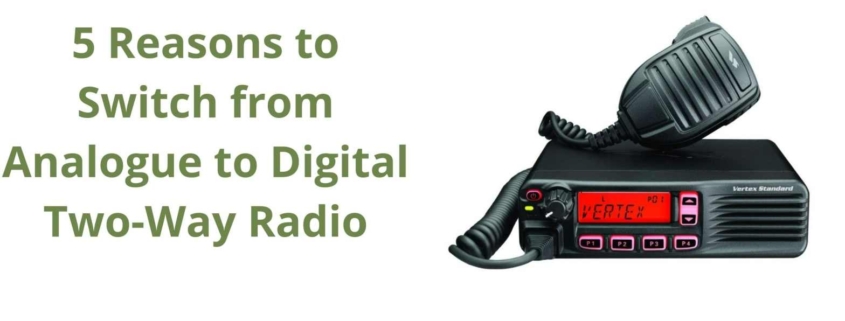5 Reasons to Switch from Analogue to Digital Two-Way Radio
In the office, a two-way radio might be a game-changer. An employee could use a radio to warn a coworker to turn off a machine or engage a machine guard if there is a possible threat. Outside confined places, safety attendants may use radio equipment to keep in touch with workers inside and, in the event of a problem, ask for help. Choosing between digital and analogue two-way radios can have significant ramifications for your workforce regarding safety, range, clarity, and functionality.
Here are some things to think about.
Digital Walkie Talkies Replace Analogue Walkie Talkies
Since the 1930s, analogue radios have become the go-to solution for businesses looking for reliable and long-lasting voice communications.
These devices offer a simple communications network, but they have limitations in assuring quality voice connections and strong reception.
Analog radios amplify all noises picked up by the microphone, making it difficult to understand voices properly in noisy surroundings.
Furthermore, radio interference causes static to interrupt transmissions between analogue circuits, and voice can become less audible when the gadgets are utilised at the edge of coverage zones.
Digital radios have arrived. While analogue radios were formerly the industry norm, two-way digital radios are now more widely used.
These devices have several improvements over their analogue predecessors, including greater speech quality, signal intensity coverage, longer battery life, and increased radio capacity.
Moreover, whereas two-way analogue radios typically allow one two-way conversation per channel, limiting a team’s ability to work collaboratively and conduct personal discussions, digital radios enhance the functionality of voice communications by allowing for one-to-one interaction and push-to-talk opportunities, which improve safety training.
Reasons to switch from Analogue to Digital Two-Way Radio.
To access modern, improved capabilities on analogue radios, you’ll need to buy a completely new radio device. Analog radios do not have any software-based business applications. Because digital radios are software-based, they may be updated with new features.
Software upgrade
Many new software products are available with digital radios, including a one-touch emergency button that instantly alerts others if there is a problem.
“The lone worker” safety alert that sends an alert system to the crew; if a user is in hazard, remote broadcasting controls to turn radio equipment on or off, change the channel, increase the volume, track specific radiolocation, and even a widget to interrupt the signal if you need to send an emergency message.
Increased Coverage
While both analogue and digital radios may transmit over the same distance, digital radio will remain loud and clear until the end of the covered zone. In contrast, an analogue radio would fade. As a result, the message will get garbled as users walk further away from the covered zone.
Increased Capacity of the Channel
When using analogue radios, a single discussion takes up the entire channel. Therefore, if you want to talk to someone, you must change to a different channel.
Digital radios allow multiple individuals to converse on a single channel without interfering with one other or compromising their privacy.
Improved speech quality
Even in the presence of background noise or a faulty signal, automatic error correction maintains voice clarity. In addition, speech is digitally coded, which means that even in the harshest conditions, advanced algorithms may deliver clear sound.
Greater capacity
Digital bandwidth vastly exceeds that of analogue. Moreover, it’s so efficient that it could double the capacity of the existing 12.5kHz channel, thus saving you money on licensing fees.
Switching to digital radios has other advantages. Your company’s investment in the product could potentially result in increased efficiency. They may also improve safety by lowering the risk of miscommunications caused by poor coverage and crossed channels, which are significant concerns with analogue radios.
There will be fewer costly industrial injuries as a result of increased safety. On the other hand, moving to digital could be viewed as a wise long-term investment, particularly for businesses seeking a competitive advantage through high-end capabilities.



